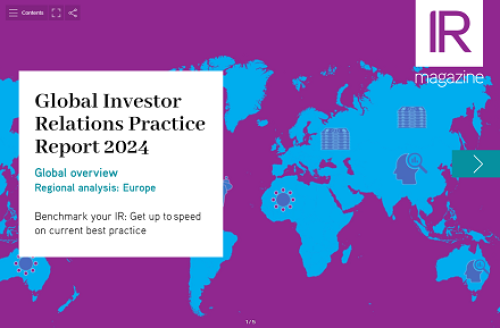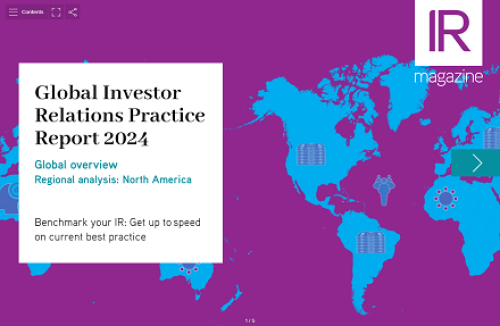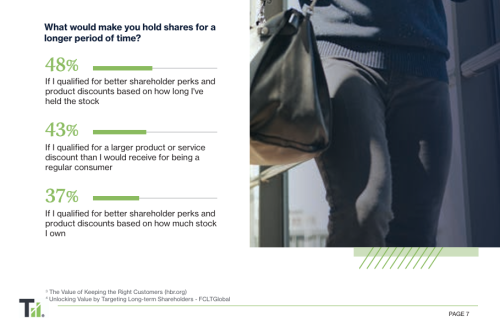A collection of the most thought-provoking comments from this IR magazine think tank
Separating the signal from the noise
‘We were already interested in looking at what drove our stock before the May 2010 Flash Crash, but getting caught up in it really brought into focus the need to understand all the layers of activity in our volume – speculative trading, program trading, arbitrage, and so on. Our traditional approach was surveillance, but that was only a fraction.’
‘I worry about high-frequency traders creating excess volatility. They’re practically terrorists in their ability to drive stocks, particularly in fast markets. Volatility in policy and volatility in markets are killers of capital formation.’
‘Small brokers are going out of business and one of the major reasons is that there’s no spread anymore. They’ve been replaced by renters who don’t care what companies do. One idea would be to mandate a minimum spread increment so we could drive back in real liquidity.’
Macro-driven markets, indexation and ETFs
‘Some people blame the dramatic swings in the market recently on exchange-traded funds (ETFs). But it’s more to do with how market structure and investment styles are different now. There’s more macro-correlation with international markets, with more fundamental investors incorporating macro factors into their analysis. That whipsaw trading activity is quite insane, but it’s not because of ETFs.’
‘IROs have to believe the work they’re doing directly influences stock prices, that over the long run their large, long-term investors are the price makers and other forms of investment are generally going to be price takers. The problem is that over the last five years IROs have seen a lot more price takers.’
‘We are seeing an increase in overall allocation to international and global portfolios – about a 20 percent increase since the March 2009 market trough. That means IROs are no longer competing against their domestic counterparts in the competition for capital; now they have to put their investment story in a global context.’
From channel-checkers to social networks
‘There’s a burgeoning danger out there, and it’s not about using social media for corporate disclosure. It’s the danger around the personal use of social networks, whether it’s a tweet about the end of the quarter or a LinkedIn profile that includes details of an employee’s role. In fact, LinkedIn is a ripe list of people for an analyst to contact or, even worse, for expert networks to call.’
‘A lot of companies are developing social media guidelines and policies, but they’re more focused on outbound messages than on educating employees about what constitutes a disclosure breach.’
‘Companies have not been good at integrating social media into their disclosure policies. There’s a disconnect between the legal department and the people actually implementing the policies, who are perhaps in IR but more likely in PR. The good news it that a lot of what employees are doing on the social media side doesn’t have any legal impact: an employee blogging about food probably isn’t going to reveal any material non-public information.’
Predictions for the 2012 proxy season
‘There will be a lot of noise about proxy access in 2012, including shareholder proposals for companies to adopt it, but everyone I’m talking to thinks we’ll see only a handful of proposals, and those will be directed at companies with glaring governance or performance problems.’
‘A significant uptick in shareholder activism was expected in 2011 but it didn’t materialize. One factor in the lead-up to last proxy season was all the cash on corporate balance sheets, and it largely remains. But with the potential for a double-dip recession and the continued difficulty in the financial markets, it’s difficult for an activist to suggest what to do with that cash.’
‘The most important trend is the greater tendency for companies and activists to settle. There has been a softening in the attitudes of company executives about activists, which has contributed to the decision that fighting isn’t the best option.’
The hedge fund viewpoint
‘We’re a long-short fund manager, so we believe companies are differentiated: the bad ones should go down and the good ones should go up. In August the US had the highest correlation of stocks in the history of the market – higher than the great depression, higher than the 1987 crash, higher than the 2008 post-Lehman effects.
‘It didn’t matter what IROs did or how their company was performing, we had something like 93 percent correlations in the market, which has no basis in economics whatsoever. While this was happening, investing time horizons completely collapsed: the average holding period for a stock on the S&P 500 today is four months. What are investors looking for? Three things: yield, in whatever form: growth, and I mean organic growth, not manufactured growth; and simpler communications.’
Sponsors
IR Magazine Think Tanks are free, invitation-only events for select groups of senior-level IR professionals. Find out about upcoming think tanks at www.irmagazine.com/events.










